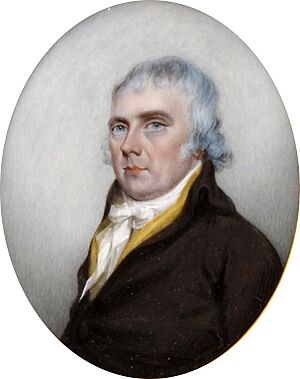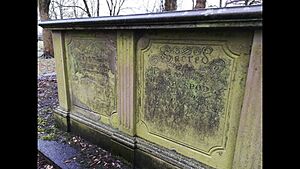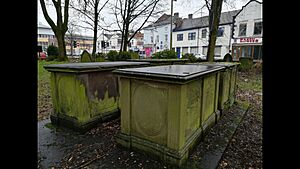Josiah Spode facts for kids
Josiah Spode (born March 23, 1733 – died August 18, 1797) was a very important English potter. He started the famous English Spode pottery company, known for its high-quality products. He is often recognized for bringing blue underglaze transfer printing to Staffordshire around 1781–1784. He also created and introduced an improved recipe for bone china around 1789–1791. This recipe became the standard for all English bone china from then on.
Contents
Who Was Josiah Spode?
Josiah Spode was a key figure in the history of English pottery. His work helped make Staffordshire a world-famous center for pottery production. He was known for his creativity and for improving how pottery was made and decorated.
Early Life and Learning
Josiah Spode was born in Lane Delph, a part of Fenton, Staffordshire. He came from a humble background and lost his parents when he was young. In November 1749, when he was about 16, Josiah began working for a skilled potter named Thomas Whieldon. He stayed with Whieldon until 1754. During this time, he worked alongside Josiah Wedgwood, another famous potter who later became Whieldon's business partner. Spode learned a lot about pottery making during this period.
Josiah married Ellen Finley in 1754. They had several children, including their eldest son, Josiah (II), born in 1755. Josiah Spode also enjoyed playing the violin.
Building His Pottery Business
In 1767, Josiah Spode rented a factory in Church Street, Stoke-on-Trent. He worked with partners to grow his business. In 1776, he bought an old pottery works in Stoke. This was the same location where the famous Spode factory would later stand, operating for many years. Josiah's business was very successful, especially with his creamware (a type of cream-colored pottery) and pearlware (a fine white-glazed earthenware).
Around 1775, Josiah's eldest son, Josiah (II), married Elizabeth. Josiah the elder used this opportunity to set up a regular business in London. Between 1775 and 1782, Josiah II managed a warehouse in London, helping to sell their pottery. Josiah Spode I became an important figure in London's business community in 1778.
Spode's Big Innovations
Josiah Spode is famous for two major contributions to pottery.
Blue Transfer Printing
He is credited with bringing underglaze blue transfer printing to the Staffordshire potteries between 1781 and 1784. This was a new way to decorate pottery. It involved printing designs onto special paper, then transferring them onto the pottery before it was glazed. This made it possible to create detailed and consistent patterns quickly. Spode was the first to bring a perfected method of this printing to Stoke, working with skilled engravers and printers.
Perfecting Bone China
Between 1788 and 1793, Spode also developed and perfected the recipe for English bone china. Bone china is a type of soft-paste porcelain known for being very strong, white, and translucent (meaning light can pass through it). While other factories used bone ash in their pottery, Spode found a much better way to mix it. His new recipe made bone china even stronger and more beautiful. This recipe became the standard for all English bone china.
Spode's company had several stores in London. Their main warehouse was located in a building that was once a famous theater in Portugal Street, London. His firm used this location from 1795 until 1848.
Josiah Spode the elder passed away in 1797. His wife, Ellen, died in 1802. They are buried in the churchyard in Stoke-on-Trent.
Spode's Legacy and Family
Josiah Spode II (1755–1827), Josiah's eldest son, took over the business in 1797. He was well-prepared for this role, being a skilled potter and an excellent salesman. He knew a lot about selling pottery in London. He was also involved in local politics and led a group of volunteer cavalry (a type of local defense force) for a few years. He even received a special coat-of-arms in 1804. Josiah II enjoyed playing the flute.
Josiah II's grandson, Josiah IV, later founded a religious building called Hawkesyard Priory.
Samuel Spode (born 1757), Josiah I's second son, took over another factory his father built for him. This factory made a type of pottery called salt-glazed wares. Samuel's son, also named Josiah, moved to Tasmania and held an important position there.
After several generations, the Spode company was managed by the Copeland family for many years. Today, the Spode name and some of its famous designs are owned by the Portmeirion pottery company.
See also
- Spode
- Samuel Spode
- Spode Museum
- William Henry Goss
- W.T.Copeland




